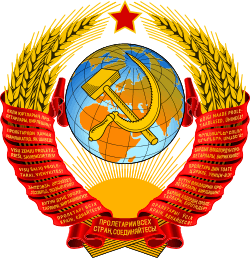Congress of Soviets of the Soviet Union
| Congress of Soviets of the Soviet Union Съезд Советов Советский Союз | |
|---|---|
|
| |
.svg.png) | |
| Type | |
| Type | |
| History | |
| Established | 30 December 1922 |
| Disbanded | 5 December 1936 |
| Preceded by |
Congresses of Soviet republics
|
| Succeeded by | Supreme Soviet of the Soviet Union |
| Leadership | |
Chairman of the Presidium of the Congress | |
| Elections | |
| Indirect elections | |
The Congress of Soviets of the Soviet Union (Russian: Съезд Советов Советский Союз), was the supreme governing body in the Soviet Union since the formation of the USSR (30 December 1922) and until adoption of the 1936 Soviet Constitution.
Election
Congress of Soviets of the Soviet Union was composed of representatives from the councils of all the Soviet republics on the following standards: from the City Council - 1 member from 25 thousand voters, from provincial (regional, territorial) and Republican congresses - 1 member from the 125 thousand residents. Delegates to the All-Union Congress were elected at the provincial (regional, territorial) autonomous republican congresses of the Soviets, or (if republic did not have provincial (and then provincial, regional) congresses) - directly at the Congress of Soviets of the union republic.
Powers
The exclusive jurisdiction of the Congress of Soviets consists of:
- Amending of the Constitution of the USSR.
- Admission of new republics into the USSR.
- Establishment of the principles of plans for development of the Soviet economy and State budget of the USSR, as well as approval of general principles of current legislation.
Congress of the Soviets shall determine the general direction of all public bodies, elect a Central Executive Committee of the USSR, responsible to Congress accountable to it.
The only chairman of the Presidium of the Congress was Mikhail Kalinin.
